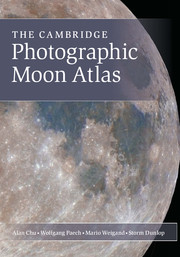Mare Orientale 19.0°S, 93.0°W
Mare Orientale (‘Eastern Sea’) is the lava-flooded, nearly circular portion of a very large impact basin. Whereas the diameter of Mare Orientale only amounts to 320 km, the basin measures about 930 km in diameter. The mare is surrounded by two ramparts, which enclose the lava surface with concentric rings, and which were created by seismic shock waves from the impact. These circular mountain ranges are known as Montes Rook (the Rook Mountains, named after Lawrence Rook, an English astronomer and observer of Jupiter's moons (1622–1666) and Montes Cordillera, where Montes Cordillera form the outer rampart.
Only the eastern outer regions of Mare Orientale are visible – at favourable libration angles – including:
the eastern edge of Montes Cordillera (20.0°S, 80.0°W),
the eastern edge of Montes Rook (20.0°S, 83.0°W),
Lacus Autumni (‘Lake of Autumn’, 14.0°S, 82.0°W), and Lacus Veris (‘Lake of Spring’, 13.0°S, 87.0°W).
Lacus Autumni is a narrow lava area, oriented north-south, about 250 km long at the inner edge of Montes Cordillera. Lacus Veris consists of two neighbouring, similarly narrow, lava areas with a total length of about 550 km at the inner edge of Montes Rook.
The ejecta from the Orientale impact may be traced out to distances of 1200 km, for example on the floor of the crater Schickard.
